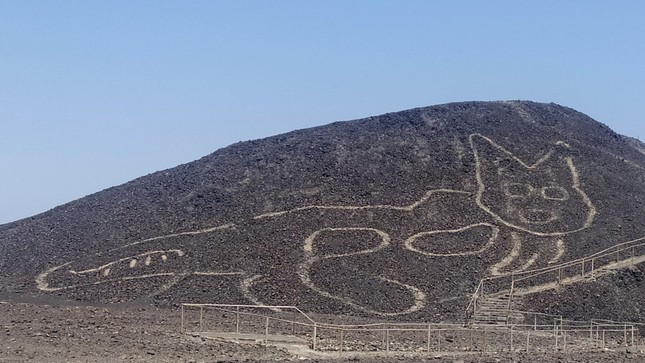Massive 2,000-Year-Old Cat Drawing Discovered In Peru

Well, it's not every day you unintentionally stumble across a drawing of a giant cat dating back to pre-common era times, but last week, a group of Peruvian workers did just that. Archeologists remodeling a UNESCO World Heritage site in southern Peru accidentally discovered a 2,000-year-old etching of a kitty cat lying on the side of a mountain, the nation's Ministry of Culture announced last Thursday. The ancient cat is a tall boi, clocking in at 37 meters long (or 121 feet long for us English System-using Statesians), and appears to be engaged in every feline's favorite past time, basking in the sun, sporting big, round eyes, pointy ears, and a long tail. Sounds like a purr-fect way to spend the past two millennia.

Our new kitty friend is a part of the Nazca Lines, an ancient series of geoglyphs depicting people, abstract designs, and animals, including monkeys, birds, and orca whales. However, the cat is a bit different than the others. Dating back to 200 BCE, the drawing may have been created by the Paracas people, who, according to Vice Media," ... predate the Nazca culture that produced most of the region's iconic geoglyphs between 200 to 700 CE."
"The discovery shows, once again, the rich and varied cultural legacy of this site," the ministry said of the design in a statement.
Don't Miss
Now, reader, I know what you're thinking -- how do you manage to lose a 121-foot-long cat drawing? Aren't mountains stationary? That's like losing 17 Shaqus standing still for centuries on end. It seems pretty hard. Well, after sitting out for 2,000 years, the cat, which lives at the Mirador Natural lookout point, "substantially faded over the centuries," helping it stay under the radar for so long.
"The figure was barely visible and was about to disappear due to its location on a fairly steep slope and the effects of natural erosion," the government agency said. "In the last week, cleaning and conservation of the geoglyph was carried out, which shows the figure of a feline represented with the body in profile and the head in front, whose lines were mostly well defined by a line of variable width between 30 and 40 centimeters."
Similarly, there's a good chance the cat won't be the last geoglyph discovered in the area. "Given that more than 140 geoglyphs were found in 2019, there are likely many more of these creations awaiting discovery," Vice reported.
Ancient drawings of giant cats -- the one thing we actually need more of this year.
For more weird internet content, follow Carly on Instagram @HuntressThompson_ and on Twitter @TennesAnyone.